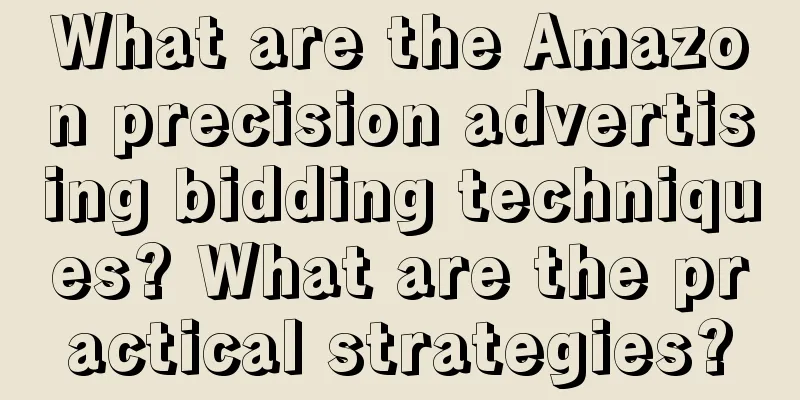What are the Amazon precision advertising bidding techniques? What are the practical strategies?

|
According to what we know, there are two types of bidding strategies for Amazon advertising campaigns: dynamic bidding and fixed bidding. Regardless of which method is used, merchants need to understand it. The following content will share some bidding tips with you. What are the Amazon precision advertising bidding techniques? 1. Ignoring Optimized Bidding If sellers want to gain benefits from bidding, they must optimize their bids. Many sellers ignore optimizing their bids and keep all ad bids the same without changing the bids. 2. Setting bids by guesswork When setting advertising bids, some sellers make bids based on their feelings, thinking that their sixth sense is very accurate. However, advertising bidding is not metaphysics and needs to be supported by data. 3. Bidding recklessly Bidding recklessly can cause your ads to cost too much. Just like guessing, bidding recklessly can hurt your ads’ performance. Don’t make drastic changes to your bids without evidence, unless you have sufficient data. 4. Excessive pursuit of low ACOS When new sellers discuss the advertising goals they want to achieve, low ACOS is one of the goals. Although ACOS of 1% looks good, you must have a lot of advertising budget left, so sellers should not be stingy with their bids. What are the practical strategies for Amazon advertising bidding? 1. Bid based on historical records Data can help sellers succeed. All sellers have to do is find the perfect CPC (cost per click) by calculating the revenue per click. Calculate the total x amount earned by the keyword and then divide it by the total number of clicks on the keyword to calculate the revenue per click. Calculate the revenue per click for the past 30 days, 60 days, and 90 days, understand the seasonal factors that affect the revenue per click, and the long-term effectiveness of keywords. After calculating the revenue per click, divide it by the target ACOS. The result is CPC, which is your bid. Here’s a simple trick: divide your target ACOS by your current ACOS, then multiply that ratio by your current CPC to get a CPC that meets your metrics. 2. Set expected conversion rates If there is no relevant advertising data for a product, the seller cannot calculate the bid based on historical records. However, the seller can set an expected conversion rate. 1) Expected conversion rate 2) Price of X 3) Target AcOS The expected conversion rate is how many clicks are needed to convert X. Amazon's average conversion rate is around 10%, so sellers can use 10% as your expected conversion rate. Price X is the product price, and Target ACOS is the seller’s ideal advertising cost. Amazon advertising is very important for sellers, and it is one of the important ways to increase exposure and sales. Therefore, Amazon merchants must pay attention to bidding skills in this regard. After mastering these skills, how can they help increase sales? Recommended reading: Should Amazon's automatic advertising keywords be denied? How to deny them? Will Amazon's suspension of advertising affect the weight? How to restore the effect? What indicators should be considered for Amazon advertising input-output? Detailed introduction |
<<: What is the difference between Amazon advertising click-through rate and conversion rate?
Recommend
8 very interesting copywriting
In this article, the author will share with you 8 ...
The history of Coconut Tree Advertising: raking in 5 billion in 25 years, getting more and more excited with each fine
This article reviews and summarizes Coco Tree’s 25...
The first batch of bloggers who entered Ailao Mountain have already failed
Recently, Yunnan's Ailao Mountain has unexpect...
How to pay off a one-time credit card? Does a one-day overdue credit card have any impact?
As a common payment tool in modern life, credit ca...
The “emotional value” of classic advertising
This article introduces three classic cases in the...
What to do if Amazon restricts replenishment? How to avoid replenishment restrictions?
When opening a store on Amazon, replenishment is a...
With low prices and weak reach, is Douyin e-commerce approaching Pinduoduo?
Recently, Douyin has made important changes to the...
What are the requirements and fees for entering Shopee? Is it expensive?
Most e-commerce platforms require certain conditio...
"Lack of consumption power" is the biggest shield in 2024
In the current economic environment, the weakening...
2 yuan a pack, earning a million a month? Young people open up a 10 billion market by opening up credit cards
With the rise of Generation Z’s consumer power, a ...
How can I successfully appeal against the deduction of points on Shopee? Why was it blocked?
There are still many rules and regulations in the ...
Is it easy to operate the Amazon no-source model? How much investment is required?
Everyone should have a certain understanding of th...
Can you make money on Amazon without a source of goods? How to do it without a source of goods on Amazon?
Now more and more people are starting to do no-sou...
How to do cross-border e-commerce on Amazon? Process Introduction
Amazon's cross-border e-commerce platform has ...
How to do Amazon market research and analysis? How much money is needed to do Amazon?
As one of the world's largest online retail pl...








![Xiaohongshu's popular article routine [June]](/upload/images/67e6d79b4c102.webp)
